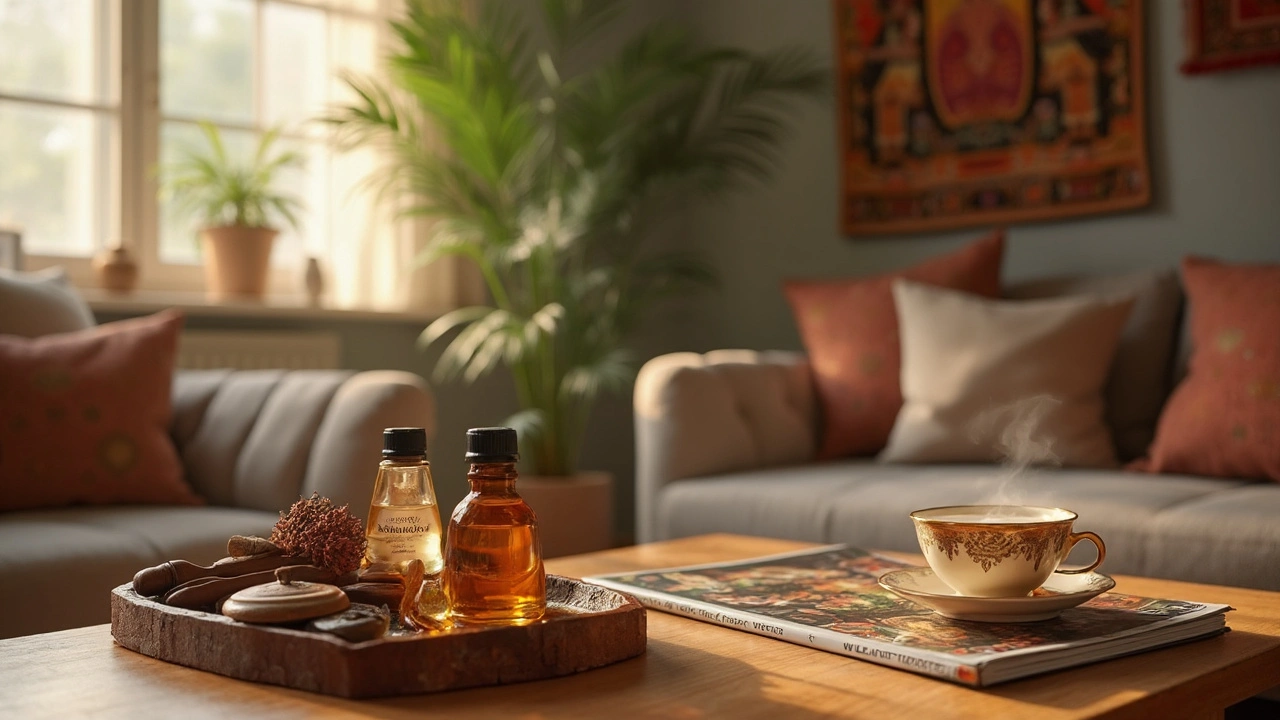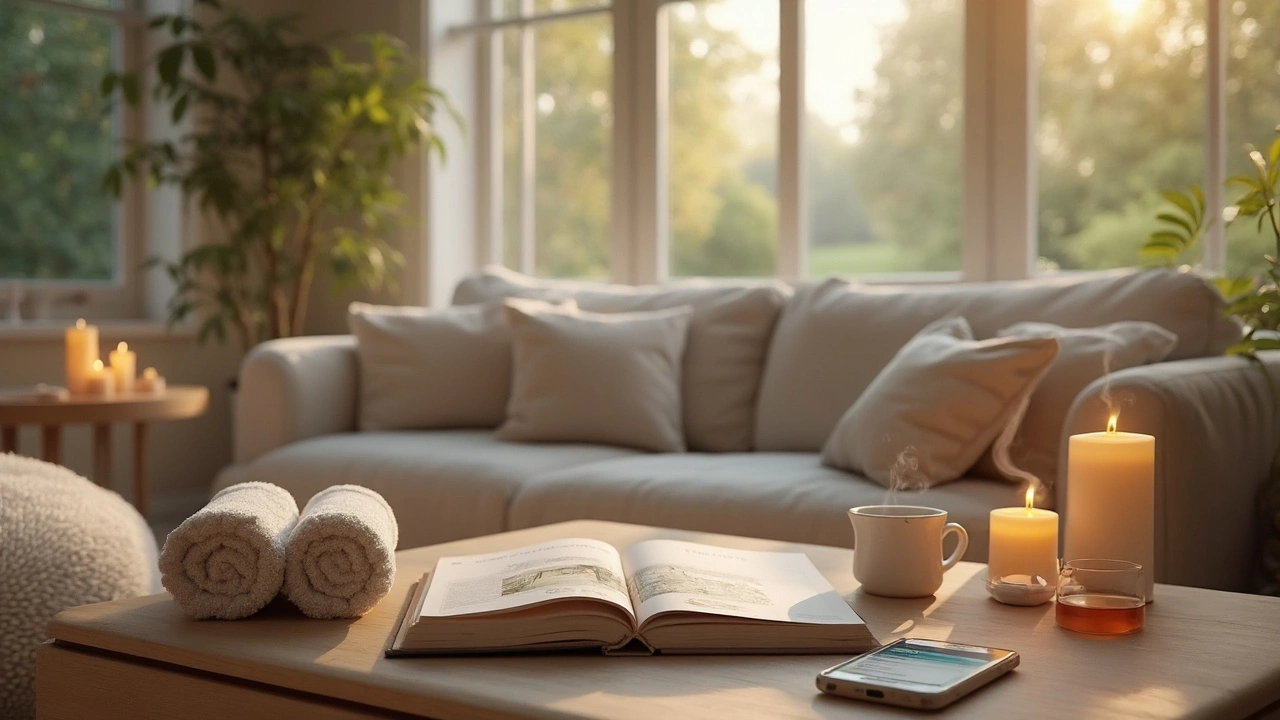Feeling stiff or burned out? Regular massage sessions near you are more than just a treat—they can boost your mood, cut stress, and even help with pain relief. This guide breaks down the real-life benefits of booking a local massage, what to expect, and how to choose the right service. You'll also find tips for keeping your sessions safe and affordable. Ready to upgrade your self-care routine?

- Created by: Liam Redgate
- Completed on: 23 Jun 2025
- Categories: Wellness
Picture a treatment that’s been passed down through generations—not just for relaxation, but to help people think, sleep, and even work better. Big corporations in cities like London sometimes offer it to employees to cut stress. It’s more than some fleeting beauty craze: Indian head massage gets people talking, lying back, and sometimes even changing their day-to-day routine because of how it feels and what it does for their minds. Why does this ancient technique, with roots far from European spas, still show up everywhere from wellness retreats to bustling office blocks? The answer comes down to a strange mix of tradition, science, and just how good it feels to have the tension kneaded away from your temples and scalp.
Discovering Indian Head Massage: A Timeless Healing Art
Indian head massage isn’t an invention of modern wellness influencers; it’s proper old school—hundreds, maybe thousands, of years old. It started out in Indian households as “Champissage,” a word that brought us the modern term "shampoo." Mothers would massage the heads of their children, and barbers would do it out on the street. While some folks see it today as just a nice add-on at the spa, in India, it’s a staple—woven into daily life. It covers the entire head, neck, and usually the top of the back and shoulders, working both muscles and energy points. People use it for headaches, for boosting energy, for shifting a bad mood, and even just to help hair look better.
This massage isn’t limited to luxury; in fact, it’s famous for how accessible it is—no fancy tables or oils needed, just skilled hands. It’s a social thing, a health thing, and thanks to a few open-minded travelers in the 1970s—especially Narendra Mehta, who brought the practice to the UK—it’s now a global service. If you’ve ever checked out an indian head massage locally, you’ve seen how it’s blended tradition and innovation.
Where It All Began: The Ayurvedic Roots of Head Massage
Indian head massage is tied closely to Ayurveda, India’s holistic system of medicine. In this tradition, the body isn’t all about bones and skin. It’s about life energy—what practitioners call “prana.” The head is seen as the seat of important energy channels. In ancient texts, massage was considered as vital as food or sleep for wellbeing. By working on the scalp, neck, and shoulders, these massages aim to unblock stuck energy and balance what's called the “doshas”—essentially, your own personal constitution by Ayurvedic thinking.
Ayurvedic experts have always used massage as both prevention and cure—everything from cold weather chills to headaches, stress, or even low mood. The oils and techniques evolved according to local climate, skin and hair types. You’d find people using sesame oil in the north for warmth and coconut oil in the south for cooling. Some families have their own secret recipes for hair oils, passed down like family jewels.
The link between Indian head massage and hair care is impossible to miss. Ask anyone in India—it’s almost a ritual, handed down mother to daughter, barber to patron. The benefits were never just hair-deep. Ayurveda saw these massages as powerful for better sleep, sharper thinking, and even longevity.
The Core Philosophy: What Is the Theory of Indian Head Massage?
This isn’t a random backrub. The theory is about balancing what’s going on beneath the surface. There are physical reasons—it relaxes tense muscles in your neck and scalp. But there’s an energetic side, too. Indian head massage focuses on “marma points”—a bit like acupuncture points, but for the Indian system. These are energy crossroads, and by pressing or circling around them, the therapist clears blockages that cause tension or low energy.
Chakra theory also comes into play. The crown, third eye, and throat chakras all get attention in a session. Massage is used to open up these centers so that prana—your life force—can flow without hindrance. This isn’t just spiritual talk; for centuries, people have believed that when these energy centers are blocked, you feel tired, foggy, or even sad. By clearing these blockages, Indian head massage is thought to boost energy, creativity, and focus. It’s a blend of science and tradition: relaxing nerves, boosting blood flow, AND channeling ancient wisdom about how our bodies store stress or joy.
What Does an Indian Head Massage Do?
Physically, it eases muscle tension in neck, shoulders, and scalp. That’s reason enough for most people who spend hours hunched over screens. It gets the blood pumping up top, so your brain feels clearer and you might notice a bit of a boost—think of how fresh you feel after a brisk walk in crisp air. If you get headaches from stress, or if your sleep is rubbish, this type of massage can really take the edge off.
Mentally, it helps you switch gears. You might walk into a session wound tight, thinking of work or chores, and leave in a sweats-and-slippers headspace. Some people even report bursts of creativity or eureka moments during or after a massage. On a more subtle level, it can help release emotions. It's not weird to suddenly feel lighter—not just in the body but in the mood, too. Studies in the UK have found that people who get regular Indian head massages report lower anxiety levels and better concentration. Beyond that, it’s been linked to better hair condition—more shine, less dryness—thanks to the oils and increased scalp circulation.
Understanding the Five Elements of Indian Head Massage
There’s a kind of recipe to a great session, made up of five key elements:
- Touch: The hands are everything. It’s the foundation—soothing, steady, always tuned in to tension or sensitivity.
- Pressure: It isn’t about brute strength or a gentle pat. The right amount of pressure melts knots without leaving you sore.
- Rhythm: Ever notice your breathing falls into sync with a good massage? That’s rhythm working its magic, setting a pace that calms the mind.
- Oils: Not always mandatory, but oils like coconut, sesame, or even almond add slip, boost scalp health, and sometimes aromatherapy perks.
- Intention: This one sounds a bit mystical but it’s real—the therapist’s focus and care matter. You can feel the difference when someone’s present and invested.
Each of these elements adds up to something beyond just hands on scalp—it’s a little ceremony that leaves your system feeling reset.
How You Feel After an Indian Head Massage
Right after, it’s common to feel a bit floaty. Some folks are almost drowsy, like they just woke up from the best nap. Others feel crystal clear—less foggy, thoughts running smoother. Itching for a coffee or a snack post-treatment is pretty normal, too; massage increases blood flow and you just might get a bit hungry or thirsty.
Emotionally, you might feel more settled. People sometimes describe a release—a weight off their mind, shoulders dropped down from around their ears. Others get the urge to take a long walk or journal, just to soak up how good their head feels. If you’re prone to migraines or tension headaches, you might notice they ease off for a while after. Sleep that night tends to be especially deep—even if you’re someone who usually struggles with insomnia.
Should You Wash Your Hair Before an Indian Head Massage?
This is a classic question. The answer depends mostly on preference, but here’s how it goes: if you want oils used in your session, most therapists say don’t bother washing pre-massage. Oils like coconut or sesame are meant to soak in—leave them on for a few hours for maximum nourishment. If you’re planning to go out straight after and don’t want greasy hair, ask in advance for an oil-free session or plan a quick wash after.
If you’re coming in after a workout or you’re concerned about hygiene, go ahead and give your hair a gentle wash. The scalp is the main focus, but therapists don’t mind working with day-old hair. Want more advice about session prep? Check out this handy guide on what to wear for comfort.
Indian Head Massage in Modern Spa Treatments
These days, Indian head massage shows up on spa menus from luxury hotels to urban wellness centers. It often pops up as a quick “lunch break special”—sometimes just 25 minutes of tension release for busy office workers. Many London spas blend it with other treatments, like facials or full-body massages. You don’t need to strip down or climb onto a massage table—a regular chair will do. That’s part of the charm: you can slot this into your schedule without fuss.
Western practitioners have borrowed and blended the tradition, sometimes using less oil, sometimes adding bits of reflexology or aromatherapy. Some even include relaxing soundscapes or guided meditative elements. You’ll find Indian head massage in gyms, yoga studios, and at mobile therapy events—where therapists come around to offices, popping stress bubbles for staff right at their desks. Those looking for a longer escape can book into an indian massage in London and enjoy a tranquil hybrid of East and West.
Techniques Used in Indian Head Massage
Masseurs use a variety of strokes, pinching, kneading, and even gentle hair tugging. They might start with circular movements on the scalp—imagine someone making figure-eights with their fingertips—as well as tapping or raking motions. The neck and upper back get their fair share too; these spots hold much of the day’s stress.
Therapists may focus on the temples, behind the ears, and along the jaw (great for teeth clenchers and screen addicts). Some incorporate subtle chakra balancing work—hovering hands, gentle pressing, or energetic “sweeps” to encourage flow. Each session is adapted to the client: more relaxing and gentle if you’re frazzled, or invigorating strokes if you need a jolt of energy. There’s no one-size-fits-all approach, and that’s why people keep coming back to find what works for them.

Tools and Oils in Indian Head Massage
Oils make all the difference for many. Coconut oil is great for cooling and nourishing. Sesame oil is warming, which suits cold weather or achy muscles. Sweet almond oil is lighter—less sticky, less scent, but still softening for skin and hair. You might see blends featuring herbs like brahmi for mental clarity, or hibiscus for hair growth.
More recently, some therapists use tools like Kansa wands—bronze domes from Ayurveda that are gently glided over the scalp and forehead. These claim to balance pH and improve skin tone, and people seem to love the unique sensation. Scalp massagers with flexible nubs are another addition, though nothing beats skilled hands for finding and releasing tension. Essential oils, such as lavender or rosemary, are sometimes added for a fragrant boost or to target stress and tension even more deeply.
How Long Is a Typical Indian Head Massage?
Sessions can be as brisk as 15–20 minutes or as indulgent as an hour. Most spa versions last around 30 minutes, enough to hit all the main areas without getting rushed. If you book privately or for home sessions, you can customize—some people want extra time spent on the face, or a longer scalp focus. At festivals or corporate events, it’s common to get 20 minutes—just enough to melt the stress without taking up half your workday.
Some regulars schedule in a massage weekly, using it like a tune-up for body and mind. If you’re short on time or want a taste, there are “express” sessions perfect for lunch breaks or as a quick reset. Want a full rundown of options? You can always ask your practitioner how they structure their session before booking.
Contraindications and When to Avoid This Massage
While Indian head massage is safe for most, there are situations where you should give it a miss or check in with your GP. Skip it if you have any scalp infections, open wounds, or skin conditions that might flare up. If you’ve got a recent head or neck injury, high fever, or complex medical history (especially neurological diseases), caution is key. Pregnant clients should let the therapist know—some points are best avoided during pregnancy.
For those with very sensitive skin or allergies to oils, it's wise to do a patch test or request an oil-free session. People with recent hair transplants or surgery near the scalp should wait until fully healed (usually at least six months, but check with your surgeon). Honest consultation before the massage ensures it’s a positive, safe experience every time.
Benefits of Indian Head Massage for Mental Health
You hear about stress reduction all the time, but Indian head massage genuinely delivers. The act of slowing down, even for just 30 minutes, triggers the body’s “rest and digest” response—lowering cortisol, boosting serotonin, and just plain relaxing you. Therapists across London say clients come in wired and leave mellow—even tough cases who say, “I never relax.”
For anxiety and low mood, it’s a hands-on, tangible shift. There’s a real sense of ritual that helps break the cycle of overthinking. Regular sessions boost the effects—better sleep, more consistent focus, a sense of being “in your body” rather than lost in your phone or worries. Combine this with deep breathing during the massage, and you’re setting up your mind for a proper reset.
Learning the Craft: What Is an Indian Head Massage Course?
Unlike some massage techniques that take years to master, Indian head massage is accessible. Courses are offered by accredited schools, therapists, and even some spa chains. Training usually involves understanding theory, anatomy, practical technique, and client care. You’ll learn proper hand positions, pressure points, and how to tailor sessions for different needs—whether relaxation, energizing, or therapeutic.
Course lengths vary. Some are a weekend, others are several weeks. There’s a focus on hygiene, oils, contraindications, and adapting for special situations (like pregnancy or injury).
Why Take an Indian Head Massage Course?
If you’re a massage therapist or spa worker, adding this to your skill set is a no-brainer. It can set you apart—few treatments are as portable and in-demand. Some people study for their own health or to help friends and family (think parents wanting to soothe restless kids or partners tackling tension at home). You don’t need a medical degree, just an openness to learning hands-on. For anyone interested in holistic health or even self-care, it’s an avenue into touch therapy that’s as grounding as it is rewarding.
Massage Course Formats: Online, In-Person, and Hybrid
Can you really learn something so hands-on online? Turns out you can—at least the theory, safety, and basic techniques. Many courses start with online modules (think anatomy, history, and techniques via video). In-person practice is crucial for mastering pressure and rhythm. Hybrid setups—combining both—are now popular, especially for those fitting study around work.
In-person courses let you practice, get feedback, and watch pros in action. Online options suit self-paced learners or those far from urban centers. If you’re looking for proper certification, check what’s required (practical exams, case studies, etc.), especially if you want to work in wellness centres or spas.
Course Content: What Will You Learn?
Here’s a peek at what usually makes up a course:
- Anatomy of scalp, neck, and shoulders.
- Key marma points and pressure spots.
- Oils, blends, and how to use them effectively.
- Session structure—from greeting a client to aftercare advice.
- Consultation, health checks, and contraindications.
- Chakra and energetic theory (even if just basics).
- Business skills—setting up as a solo practitioner or working in spas/salons.
- Professional boundaries and ethics.
Most courses blend hands-on demos, partner practice, and written material.
Accreditation and Certification for Indian Head Massage
To practice professionally (or get insurance cover), look for courses accredited by big names like the Federation of Holistic Therapists (FHT) or Complementary and Natural Healthcare Council (CNHC) in the UK. A good school guides you through certification so you’re legit—completing practical assessments, getting a diploma or official certificate, and gaining ongoing support. Don’t settle for unaccredited courses if you plan to go pro; clients and employers value proof of qualification.
Career Opportunities After Completing a Massage Course
With this skill, the work world really opens up. You can go freelance, offering mobile services in homes, offices, or events—great for those wanting flexibility. Spas and beauty salons love therapists who can multi-task, and Indian head massage makes for an easy, profitable add-on service. Corporate companies increasingly bring in therapists for staff; it boosts morale and productivity. Yoga studios and wellness centers also add head massage sessions to their menus, balancing physical and energetic needs.
Some go niche, specializing in scalp and hair health, collaborating with naturopaths or nutritionists. Others teach workshops, lead retreats, or sell their own line of massage oils. Once certified, you’ve got room to carve your own path in an ever-growing wellness industry.
Combining Indian Head Massage with Other Techniques
Why keep this skill solo? Head massage blends brilliantly with Swedish or deep tissue work, especially for clients who store stress up top. Reflexology fans like to tag on head sessions for a full body-mind reboot. Reiki practitioners often use Indian head massage as an entry point—combining energy clearing with muscle relaxation. Sometimes, facialists integrate a shortened version for glow-boosting results at the end of a treatment. Experimenting with combos often brings the best results, for both new clients and returning regulars.
FAQs: Real Questions from Curious Clients
What does an Indian head massage do?
It relieves muscle tension, soothes headaches and neck pain, clears mental fog, and can lower anxiety. By boosting scalp circulation, it might even help your hair look and feel healthier.
What are the 5 elements of Indian head massage?
Touch, pressure, rhythm, oil, and intention—each as important as the next, combining for maximum effect.
What is Indian head massage NHS?
It’s not offered routinely on the NHS, but some NHS wellness initiatives use it for staff relaxation or as part of holistic therapy programs.
How do you feel after an Indian head massage?
Most people feel relaxed and a bit dreamy, with less tension and often a mood lift. Some get sleepy, others feel refreshed and clear-headed.
What is the theory of Indian head massage?
It’s based on balancing energy flows, stimulating key marma points, easing muscle tension, and promoting mental calm by working on head and shoulders.
Should I wash my hair before Indian head massage?
Not required—unless you want. If oils are used, it’s best to leave them on for a few hours post-treatment for extra scalp and hair benefits.
Final Thoughts: Is Indian Head Massage Right for You?
If you spend your life staring at screens, get tension headaches, or just want a carve-out for real self-care, Indian head massage is tough to beat. It weaves together touch, energy awareness, and centuries-old wisdom—without needing a spa day or expensive gear. Whether you book one at a high-end London spa or try a home treatment, this ancient practice gives your mind and body a reset that’s both practical and, for many, a little bit magical.
Explore the top body massage retreats in London that promise ultimate relaxation and rejuvenation. Discover a variety of massage styles, from traditional Swedish to deep tissue, aimed at soothing your stress away. Whether you're a local or a visitor, these retreats offer serene sanctuaries in the bustling city, ensuring a refreshing escape. Learn how to find the best spots, what to expect during a session, and tips for a safe and enjoyable experience.
This guide gives you the lowdown on outcall massage—what it is, why it’s awesome, and how to book it safely. You’ll learn about the different types of massages you can get right in your living room and how much you might pay. We’ll walk through how a session actually feels, how to find the best services, and how to keep things safe and comfortable. There’s even a handy comparison table and answers to all your burning questions. Ready to bring the spa to your sofa? This article covers everything you need.



